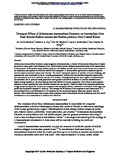Divergent effects of Schistosoma haematobium exposure on intermediate-host snail species Bulinus nasutus and Bulinus globosus from coastal Kenya

Date
2017Author
Kariuki, H Curtis
Ivy, Julianne A
Muchiri, Eric M
Sutherland, Laura J
King, Charles H
Metadata
Show full item recordAbstract
Schistosoma haematobium infection causes urogenital schistosomiasis, a chronic inflammatory disease that is highly
prevalent in many parts of sub-Saharan Africa. Bulinid snails are the obligate intermediate hosts in the transmission
of this parasite. In the present study, Bulinus globosus and Bulinus nasutus snails from coastal Kenya were raised in
the laboratory and exposed to miracidia derived from sympatric S. haematobium specimens to assess the species-
specific impact of parasite contact and infection. The snails’ subsequent patterns of survival, cercarial shedding, and reproduction were monitored for up to 3 months postexposure. Schistosoma haematobium exposure significantly
decreased the survival of B. globosus, but not of B. nasutus. Although both species were capable of transmitting S.haematobium, the B. globosus study population had a greater cumulative incidence of cercarial shedders and a higher average number of cercariae shed per snail than did the B. nasutus population. The effects of prior parasite
exposure on snail reproduction were different between the two species. These included more numerous production
of egg masses by exposed B. nasutus (as compared with unexposed snails), contrasted to decreased overall egg mass
production by parasite-exposed B. globosus. The interspecies differences in the response to and transmission of
S. haematobium reflect clear differences in life histories for the two bulinid species when they interact with the parasite, which should be taken into account when planning control interventions aimed at reducing each host snails’ contribution to local transmission of Schistosoma infection.
